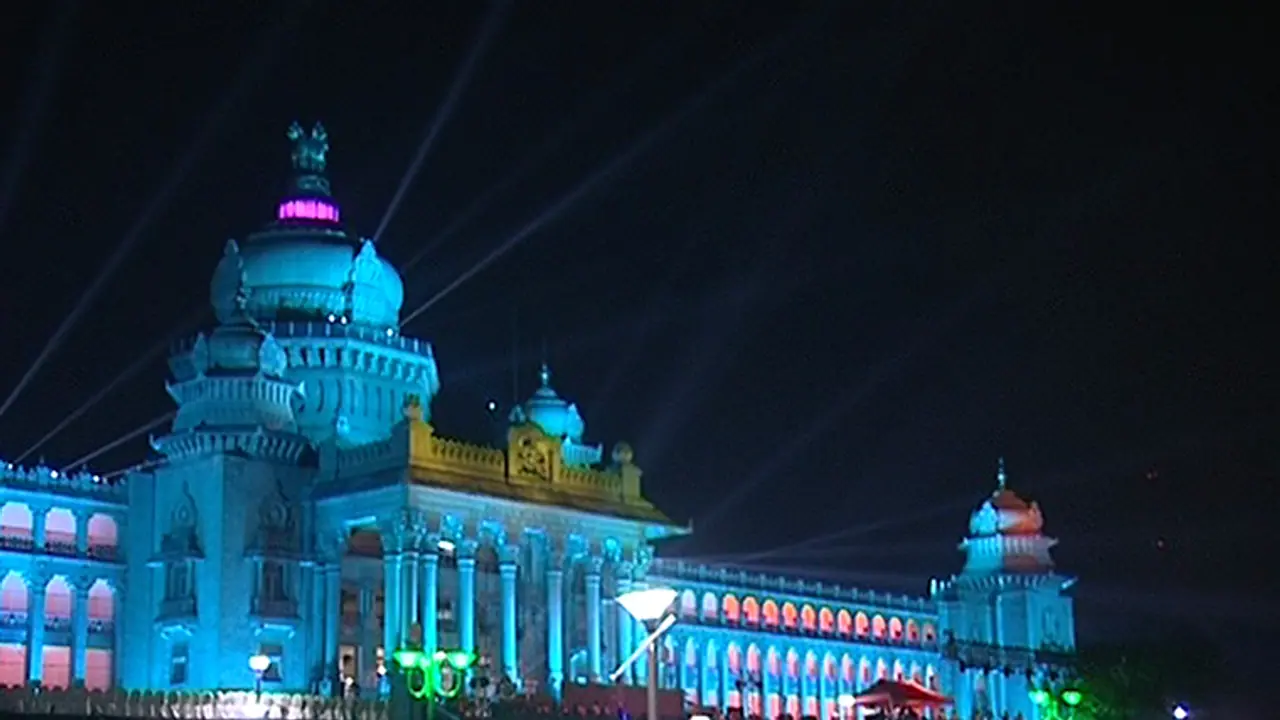Built on over 60 acres, Vidhan Soudha reflects the true indigenous style Built largely with 'Bangalore granite' procured from Mallasandra and Hesarghatta. The pink shades in the building are from 'Magadi pink' granites The Cabinet door is made of Sandalwood and the Speaker's chair is made of Mysore Rosewood It took four years to complete the structure (1951-1956) and Rs 1.75 crore was spent on it
Bengaluru would be incomplete without the mention of the iconic structure Vidhan Soudha. Not just because it is the symbol of the seat of power but also for its grandeur and beauty.

Spread over 60 acres, the imposing structure on Ambedkar Veedhi, the magnificent edifice is a marvel of architecture. Unlike other state administrative buildings in the country, the Vidhan Soudha represents a unique design that is truly indigenous.
The thought for an administrative building was conceptualised by the first chief minister of then Mysore State KC Reddy. Later, Kengal Hanumanthaiah, the second chief minister of Mysore State travelled across the length and breadth of the country to understand the construction of administration buildings.
There is an interesting story behind it. When a few Russian delegates were taken around the City then, they remarked that all significant buildings had no indigenous designs. This forced Hanumanthaiah to go in search of the unique design.
As his dream, the chief engineer BR Manickam the Vidhan Soudha was built in a neo-Dravidian architecture style, and it took four years to complete the structure (1951-56).
According to the government website, the structure comprises richly carved bases, pillars, Kapotha cornices, Chaithya arches and also deep friezes.
The building is in rectangular shape measuring 700 feet north-south and 350 feet east-west. It has inner open quadrangles on either side of the Central wing. There are three wings in the Vidhan Soudha. The northern wings have a ground and three floors while the southern wing has a cellar floor, ground floor along with three upper floors. The banquet hall is located in the central wing ground floor. This also houses the Legislative Assembly chamber. Situated at the height of 112 feet high, this is one of the largest Legislative buildings in the country.
One of the notable features of the Vidhan Soudha is the grand features in its front. It has a flight of 45 steps that lead to the Assembly Chamber in the first floor. The Assembly (on the first floor) has a seating arrangement for 268 members. Provision has been made to accommodate 100 more members. In the Legislative Council (in the first floor) can accommodate 88 members.
Perhaps, no other administration buildings in the country boast this kind of rich architecture. For, it has skillfully blending of ancient and modern architectural styles - it has features of the British, Dravidian and Indo-Islamic structure. The floral designs and decorative motifs only add to the grandeur of the Vidhan Soudha.
According to Deccan Herald, the chisellers were from Soraba and Sagara regions who richly carved the walls and doors of the Vidhan Soudha. It is a treat to watch the Assembly Hall as the hall is enclosed with Teakwood panels and the ceiling is made up of acoustic material. The cabinet door is made of Sandalwood, and the Speaker's chair is made of Mysore rosewood, reports Deccan Herald.
Not many know that the Vidhan Soudha is largely built with 'Bangalore granite' procured from areas around Mallasandra and Hesarghatta. To provide visual appeal, granites 'Magadi pink' and 'Turuvekere black' stones have been used.
One of the eye-catching features of the Vidhan Soudha is the Central dome. It is sixty feet in diameter and is supported by eight pillars.
What makes this imposing structure all the more interesting is almost 5,000 convicts from Bangalore Central Jail were employed along with other unskilled workers. The convicts were given freedom after the completion of the building.
